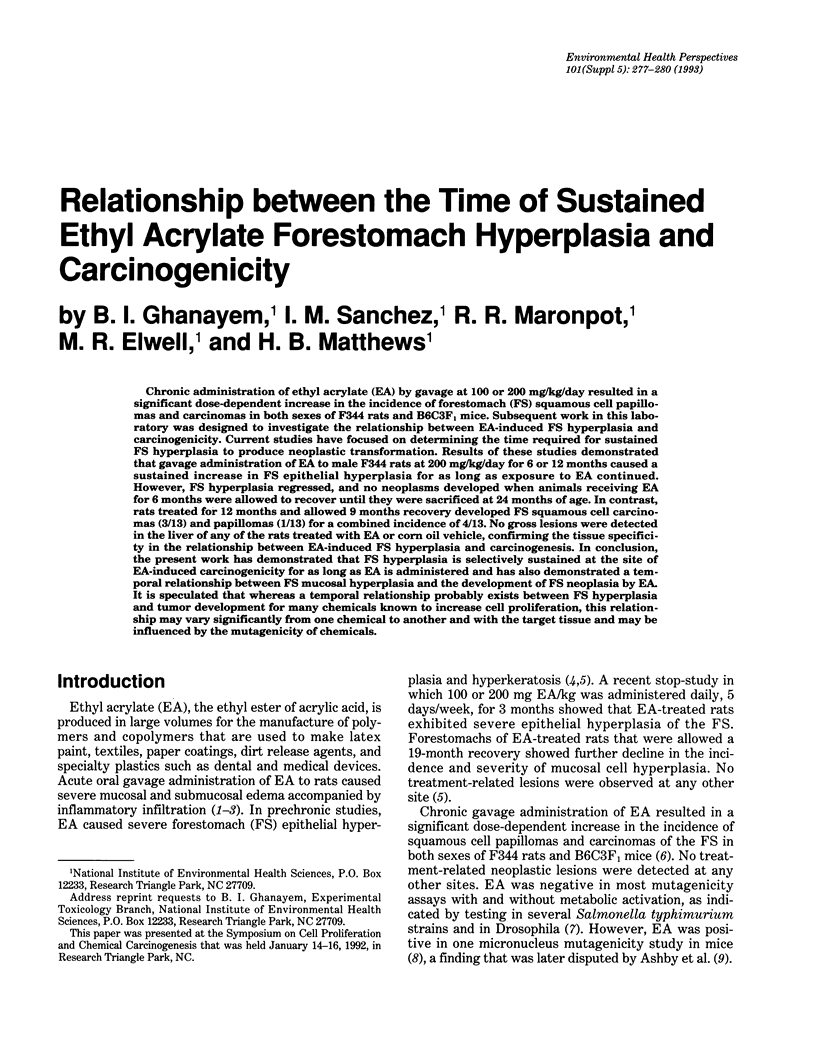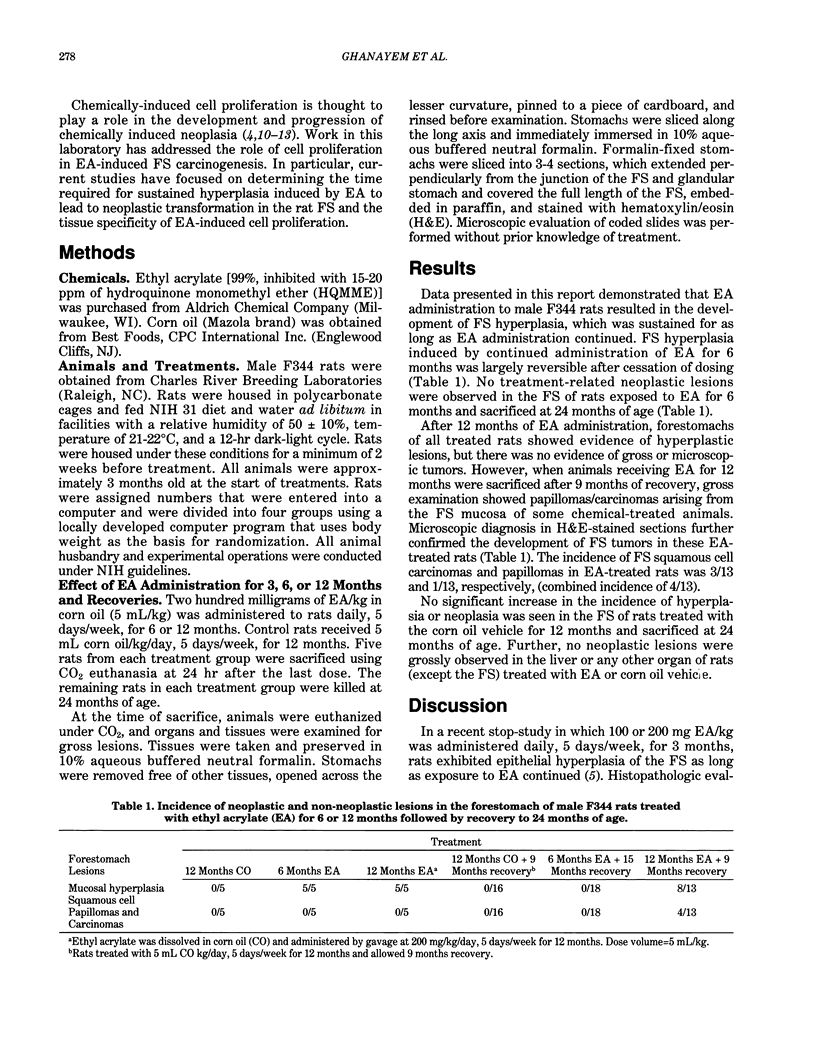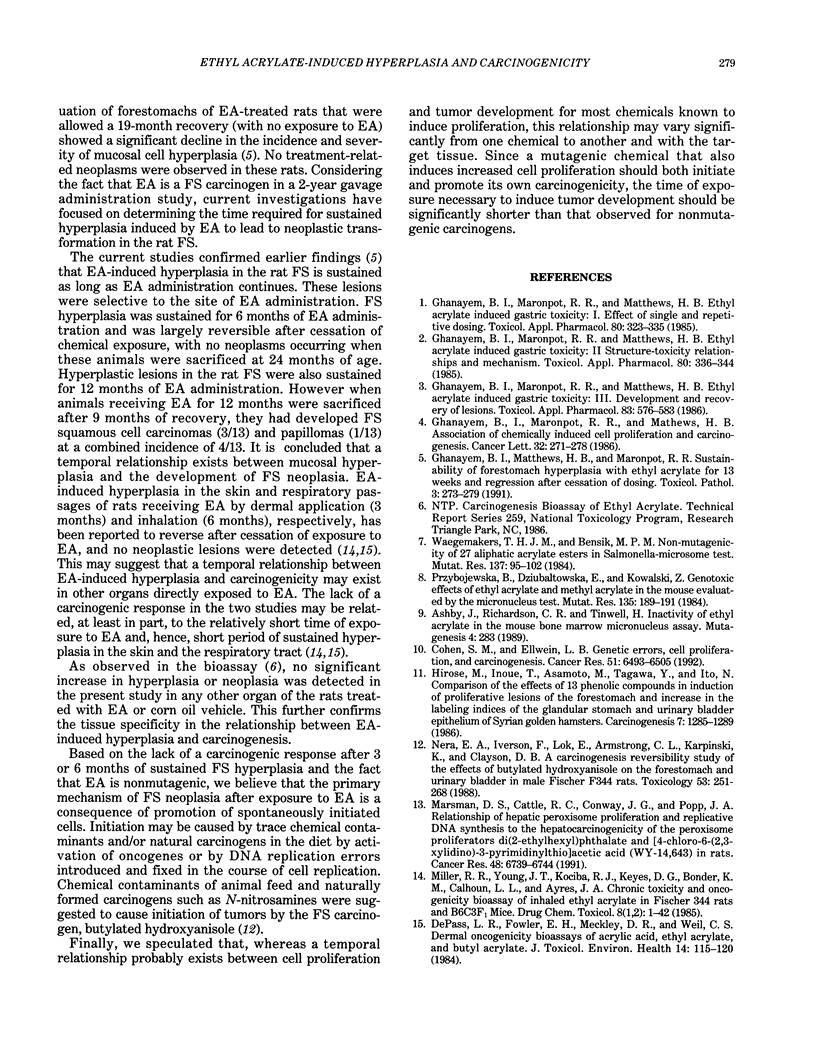Abstract
Chronic administration of ethyl acrylate (EA) by gavage at 100 or 200 mg/kg/day resulted in a significant dose-dependent increase in the incidence of forestomach (FS) squamous cell papillomas and carcinomas in both sexes of F344 rats and B6C3F1 mice. Subsequent work in this laboratory was designed to investigate the relationship between EA-induced FS hyperplasia and carcinogenicity. Current studies have focused on determining the time required for sustained FS hyperplasia to produce neoplastic transformation. Results of these studies demonstrated that gavage administration of EA to male F344 rats at 200 mg/kg/day for 6 or 12 months caused a sustained increase in FS epithelial hyperplasia for as long as exposure to EA continued. However, FS hyperplasia regressed, and no neoplasms developed when animals receiving EA for 6 months were allowed to recover until they were sacrificed at 24 months of age. In contrast, rats treated for 12 months and allowed 9 months recovery developed FS squamous cell carcinomas (3/13) and papillomas (1/13) for a combined incidence of 4/13. No gross lesions were detected in the liver of any of the rats treated with EA or corn oil vehicle, confirming the tissue specificity in the relationship between EA-induced FS hyperplasia and carcinogenesis. In conclusion, the present work has demonstrated that FS hyperplasia is selectively sustained at the site of EA-induced carcinogenicity for as long as EA is administered and has also demonstrated a temporal relationship between FS mucosal hyperplasia and the development of FS neoplasia by EA.(ABSTRACT TRUNCATED AT 250 WORDS)
Full text
PDF


Selected References
These references are in PubMed. This may not be the complete list of references from this article.
- Ashby J., Richardson C. R., Tinwell H. Inactivity of ethyl acrylate in the mouse bone marrow micronucleus assay. Mutagenesis. 1989 Jul;4(4):283–285. doi: 10.1093/mutage/4.4.283. [DOI] [PubMed] [Google Scholar]
- Cohen S. M., Ellwein L. B. Genetic errors, cell proliferation, and carcinogenesis. Cancer Res. 1991 Dec 15;51(24):6493–6505. [PubMed] [Google Scholar]
- DePass L. R., Fowler E. H., Meckley D. R., Weil C. S. Dermal oncogenicity bioassays of acrylic acid, ethyl acrylate, and butyl acrylate. J Toxicol Environ Health. 1984;14(2-3):115–120. doi: 10.1080/15287398409530566. [DOI] [PubMed] [Google Scholar]
- Ghanayem B. I., Maronpot R. R., Matthews H. B. Association of chemically induced forestomach cell proliferation and carcinogenesis. Cancer Lett. 1986 Sep;32(3):271–278. doi: 10.1016/0304-3835(86)90179-5. [DOI] [PubMed] [Google Scholar]
- Ghanayem B. I., Maronpot R. R., Matthews H. B. Ethyl acrylate-induced gastric toxicity. I. Effect of single and repetitive dosing. Toxicol Appl Pharmacol. 1985 Sep 15;80(2):323–335. doi: 10.1016/0041-008x(85)90090-0. [DOI] [PubMed] [Google Scholar]
- Ghanayem B. I., Maronpot R. R., Matthews H. B. Ethyl acrylate-induced gastric toxicity. II. Structure-toxicity relationships and mechanism. Toxicol Appl Pharmacol. 1985 Sep 15;80(2):336–344. doi: 10.1016/0041-008x(85)90091-2. [DOI] [PubMed] [Google Scholar]
- Ghanayem B. I., Maronpot R. R., Matthews H. B. Ethyl acrylate-induced gastric toxicity. III. Development and recovery of lesions. Toxicol Appl Pharmacol. 1986 May;83(3):576–583. doi: 10.1016/0041-008x(86)90240-1. [DOI] [PubMed] [Google Scholar]
- Ghanayem B. I., Matthews H. B., Maronpot R. R. Sustainability of forestomach hyperplasia in rats treated with ethyl acrylate for 13 weeks and regression after cessation of dosing. Toxicol Pathol. 1991;19(3):273–279. doi: 10.1177/019262339101900310. [DOI] [PubMed] [Google Scholar]
- Hirose M., Inoue T., Asamoto M., Tagawa Y., Ito N. Comparison of the effects of 13 phenolic compounds in induction of proliferative lesions of the forestomach and increase in the labelling indices of the glandular stomach and urinary bladder epithelium of Syrian golden hamsters. Carcinogenesis. 1986 Aug;7(8):1285–1289. doi: 10.1093/carcin/7.8.1285. [DOI] [PubMed] [Google Scholar]
- Marsman D. S., Cattley R. C., Conway J. G., Popp J. A. Relationship of hepatic peroxisome proliferation and replicative DNA synthesis to the hepatocarcinogenicity of the peroxisome proliferators di(2-ethylhexyl)phthalate and [4-chloro-6-(2,3-xylidino)-2-pyrimidinylthio]acetic acid (Wy-14,643) in rats. Cancer Res. 1988 Dec 1;48(23):6739–6744. [PubMed] [Google Scholar]
- Miller R. R., Young J. T., Kociba R. J., Keyes D. G., Bodner K. M., Calhoun L. L., Ayres J. A. Chronic toxicity and oncogenicity bioassay of inhaled ethyl acrylate in Fischer 344 rats and B6C3F1 mice. Drug Chem Toxicol. 1985;8(1-2):1–42. doi: 10.3109/01480548509011632. [DOI] [PubMed] [Google Scholar]
- Nera E. A., Iverson F., Lok E., Armstrong C. L., Karpinski K., Clayson D. B. A carcinogenesis reversibility study of the effects of butylated hydroxyanisole on the forestomach and urinary bladder in male Fischer 344 rats. Toxicology. 1988 Dec 30;53(2-3):251–268. doi: 10.1016/0300-483x(88)90218-1. [DOI] [PubMed] [Google Scholar]
- Przybojewska B., Dziubałtowska E., Kowalski Z. Genotoxic effects of ethyl acrylate and methyl acrylate in the mouse evaluated by the micronucleus test. Mutat Res. 1984 Mar;135(3):189–191. doi: 10.1016/0165-1218(84)90120-4. [DOI] [PubMed] [Google Scholar]
- Waegemaekers T. H., Bensink M. P. Non-mutagenicity of 27 aliphatic acrylate esters in the Salmonella-microsome test. Mutat Res. 1984 Aug-Sep;137(2-3):95–102. doi: 10.1016/0165-1218(84)90097-1. [DOI] [PubMed] [Google Scholar]


